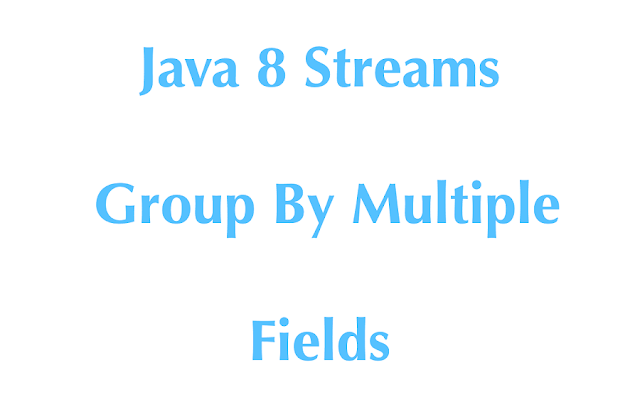A guide to group by two or more fields in java 8 streams api. Examples to grouping List by two fields.
1. Overview
In this post, We will learn how to group by multiple fields in java 8 using Streams Collectors.groupingBy() method and example programs with custom objects.
2. Group By Multiple Fields Example in Java 8
First, Create a class Employee with below properties.
int id
String name
String designation
String gender
long salary
Create argument constructor and setter, getters methods for all properties. And also add toString() method to see the Employee object in readable format.
Next, We will try to implement the group by on two fields such as designation and gender. On these two fields get the group by count.
Look at the below examples, you will see the code with the groupingBy() is used twice. This is called as Collectors chaining and observe the output.
package com.oraclejavacertified.java8.collectors.groupby;
public class Employee {
private int id;
private String name;
private String designation;
private String gender;
private long salary;
public Employee(int id, String name, String designation, String gender, long salary) {
super();
this.id = id;
this.name = name;
this.designation = designation;
this.gender = gender;
this.salary = salary;
}
public int getId() {
return id;
}
public void setId(int id) {
this.id = id;
}
public String getName() {
return name;
}
public void setName(String name) {
this.name = name;
}
public String getDesignation() {
return designation;
}
public void setDesignation(String designation) {
this.designation = designation;
}
public String getGender() {
return gender;
}
public void setGender(String gender) {
this.gender = gender;
}
public long getSalary() {
return salary;
}
public void setSalary(long salary) {
this.salary = salary;
}
@Override
public String toString() {
return "Employee [id=" + id + ", name=" + name + ", designation=" + designation + ", gender=" + gender
+ ", salary=" + salary + "]";
}
}
Example – Group By Two Properties:
package com.oraclejavacertified.java8.collectors.groupby;
import java.util.ArrayList;
import java.util.List;
import java.util.Map;
import java.util.stream.Collectors;
public class GroupingByMultipleFieldsExample {
public static void main(String[] args) {
// Creating List and adding Employees values.
List<Employee> employeesList = new ArrayList<>();
employeesList.add(new Employee(101, "Glady", "Manager", "Male", 25_00_000));
employeesList.add(new Employee(102, "Vlad", "Software Engineer", "Female", 15_00_000));
employeesList.add(new Employee(103, "Shine", "Lead Engineer", "Female", 20_00_000));
employeesList.add(new Employee(104, "Nike", "Manager", "Female", 25_00_000));
employeesList.add(new Employee(105, "Slagan", "Software Engineer", "Male", 15_00_000));
employeesList.add(new Employee(106, "Murekan", "Software Engineer", "Male", 15_00_000));
employeesList.add(new Employee(107, "Gagy", "Software Engineer", "Male", 15_00_000));
// group by - multiple fields
// Grouping by designation and Gender two properties and need to get the count.
Map<String, Map<String, Long>> multipleFieldsMap = employeesList.stream()
.collect(
Collectors.groupingBy(Employee::getDesignation,
Collectors.groupingBy(Employee::getGender,
Collectors.counting())));
// printing the count based on the designation and gender.
System.out.println("Group by on multiple properties" + multipleFieldsMap);
}
}
Output:
Group by on multiple properties
{Software Engineer={Male=3, Female=1}, Manager={Female=1, Male=1}, Lead Engineer={Female=1}}
From the output, you can clearly observe that we can see the count by designation and gender type.
In this program, we have gathered the count of employees but rather than this we can get the list of Employees.
3. Java 8 – Group By Multiple Fields and Collect Aggregated Result into List
First, Collect the list of employees as List<Employee> instead of getting the count. That means inner aggregated Map value type should be List.
To get the list, we should not pass the second argument for the second groupingBy() method.
// Example 2
// group by - multiple fields
// Grouping by designation and Gender two properties and need to get the count.
Map<String, Map<String, List<Employee>>> multipleFieldsMapList = employeesList.stream()
.collect(
Collectors.groupingBy(Employee::getDesignation,
Collectors.groupingBy(Employee::getGender)));
// printing the count based on the designation and gender.
System.out.println("Group by on multiple properties and Map key as List" + multipleFieldsMapList);
Output:
Group by on multiple properties and Map key as List
{
Software Engineer={Male=[
Employee [id=105, name=Slagan, designation=Software Engineer, gender=Male, salary=1500000], Employee [id=106, name=Murekan, designation=Software Engineer, gender=Male, salary=1500000], Employee [id=107, name=Gagy, designation=Software Engineer, gender=Male, salary=1500000]],
Female=[Employee [id=102, name=Vlad, designation=Software Engineer, gender=Female, salary=1500000]]},
Manager={
Female=[Employee [id=104, name=Nike, designation=Manager, gender=Female, salary=2500000]],
Male=[Employee [id=101, name=Glady, designation=Manager, gender=Male, salary=2500000]]},
Lead Engineer={Female=[Employee [id=103, name=Shine, designation=Lead Engineer, gender=Female, salary=2000000]]}}
4. Java 8 – Group By Multiple Fields – Avoid Collectors Chaining
We can avoid the Collectors chaining such as calling groupingby() function several times. If we want to group by 4 fields then need to call Collectors.groupingBy() also 4 times which makes code ugly and not readable.Let us create the separate class with the group by properties and write implementation for equals(), hashcode() methods for object comparisons.
Creating new class for GroupBy fields makes us to call only once the groupingBy() method.
Below examples are implemented as described and suggested way.
GroupBy Class:
class GroupBy {
private String designation;
private String gender;
public GroupBy(String designation, String gender) {
super();
this.designation = designation;
this.gender = gender;
}
@Override
public int hashCode() {
return this.designation.length() + this.gender.length();
}
@Override
public boolean equals(Object obj) {
GroupBy other = (GroupBy) obj;
if (other.getDesignation().equals(this.designation) && other.getGender().equals(this.gender))
return true;
return false;
}
public String getDesignation() {
return designation;
}
public void setDesignation(String designation) {
this.designation = designation;
}
public String getGender() {
return gender;
}
public void setGender(String gender) {
this.gender = gender;
}
@Override
public String toString() {
return "GroupBy [designation=" + designation + ", gender=" + gender + "]";
}
}
Employee Class:
package com.oraclejavacertified.java8.collectors.groupby.multiple;
public class Employee {
private int id;
private String name;
private long salary;
private GroupBy groupBy;
public Employee(int id, String name, long salary, GroupBy groupBy) {
super();
this.id = id;
this.name = name;
this.salary = salary;
this.groupBy = groupBy;
}
// setters and getters
@Override
public String toString() {
return "Employee [id=" + id + ", name=" + name + ", salary=" + salary + ", groupBy=" + groupBy + "]";
}
}
Optimized Group By Multiple Fields Example
package com.oraclejavacertified.java8.collectors.groupby.multiple;
import java.util.ArrayList;
import java.util.List;
import java.util.Map;
import java.util.stream.Collectors;
public class GroupingByMultipleFieldsExample {
public static void main(String[] args) {
// Creating List and adding Employees values.
List<Employee> employeesList = new ArrayList<>();
employeesList.add(new Employee(101, "Glady", 25_00_000, new GroupBy("Manager", "Male")));
employeesList.add(new Employee(102, "Vlad", 15_00_000, new GroupBy("Software Engineer", "Female")));
employeesList.add(new Employee(103, "Shine", 20_00_000, new GroupBy("Lead Engineer", "Female")));
employeesList.add(new Employee(104, "Nike", 25_00_000, new GroupBy("Manager", "Female")));
employeesList.add(new Employee(105, "Slagan", 15_00_000, new GroupBy("Software Engineer", "Male")));
employeesList.add(new Employee(106, "Murekan", 15_00_000, new GroupBy("Software Engineer", "Male")));
employeesList.add(new Employee(107, "Gagy", 15_00_000, new GroupBy("Software Engineer", "Male")));
// Example 1
// group by - multiple fields
// Grouping by designation and Gender two properties and need to get the count.
Map<GroupBy, Long> multipleFieldsMap = employeesList.stream()
.collect(Collectors.groupingBy(Employee::getGroupBy, Collectors.counting()));
// printing the count based on the designation and gender.
System.out.println("Group by on multiple properties" + multipleFieldsMap);
}
}
Output:
Group by on multiple properties
{ GroupBy [designation=Lead Engineer, gender=Female]=1,
GroupBy [designation=Software Engineer, gender=Male]=3,
GroupBy [designation=Software Engineer, gender=Female]=1,
GroupBy [designation=Manager, gender=Male]=1,
GroupBy [designation=Manager, gender=Female]=1
}





0 comments:
Post a Comment